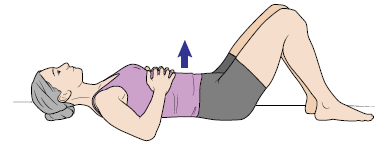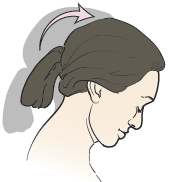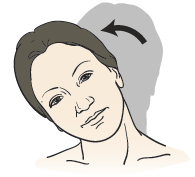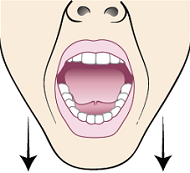This information describes exercises you can do to help manage lymphedema (swelling) in your head, neck, or both.
Exercises that help manage lymphedema are called decongestive (DEE-kun-JEH-stiv) exercises. They’re an important part of managing lymphedema. They help move lymph fluid around your body. They may also help you move better.
Talk with your healthcare provider before you start to do these exercises. They may change how often you do the exercises or how many times you repeat them. They may also change how you do some of the exercises. Follow their instructions.
With any exercise program, it’s important to build up slowly over time. Start out doing fewer reps and holding for less time. Work up to doing more reps and holding for longer. This lets your muscles get used to the exercises.
General instructions
- Do the exercises in the order they’re listed in this resource.
- Repeat each exercise 10 times, if you can. It’s helpful to count each repetition (rep) out loud.
- Do these exercises twice a day.
What to do before doing these exercises
- Dress comfortably. Your clothes should not limit your movements.
- If you have bandages or compression garments, wear them when you exercise.
What to do while doing these exercises
- Do not hold your breath. Counting each rep out loud can help.
- Only move as far as you can without feeling pain. Talk with your healthcare provider if you have questions about how to do any of the exercises.
-
You can do all these exercises while lying down, sitting, or standing. It’s most important to do them in a comfortable position while keeping good posture. Here are some suggestions for good posture:
- Look forward with your chin tucked slightly.
- If you’re sitting, choose a supportive chair. Sit up straight with your feet flat on the ground. Keep your knees in line with your ankles and your shoulders in line with your hips.
- If you’re standing, keep your hips, knees, and ankles in line with your shoulders. Keep your feet flat on the ground.
Deep breathing exercise
It’s easiest to do this exercise lying on your back. You can also do it while sitting or standing.
- Place one or both of your hands over your abdomen (belly).
-
Breathe in slowly and deeply through your nose. Your abdomen should rise (see Figure 1), but your upper chest should stay still and relaxed.

Figure 1. Breathe in so your abdomen rises - Breathe out slowly through pursed lips, like you’re blowing out candles. As you breathe out, slowly and gently pull your abdomen towards your spine.
Repeat 10 times.
Shoulder exercises
Backward shoulder rolls
- Start with your arms relaxed at your sides.
-
In a circular motion, bring your shoulders forward, up, backward, and down (see Figure 2). Try to make the circle as big as you can and move both shoulders at the same time.

Figure 2. Backward shoulder rolls
Repeat 10 times.
If you have some tightness across your chest, start with smaller circles. Make them bigger as your muscles get looser.
Shoulder blade squeezes
- Start with your arms relaxed at your sides and your palms facing up.
-
Gently squeeze your shoulder blades back and down (see Figure 3). As you’re doing this, breathe in through your nose to make your chest puff out.

Figure 3. Shoulder blade squeezes - As you breathe out, release the squeeze and go back to the starting position. Rest for a few seconds.
Repeat 10 times.
Pectoral stretch using doorway
- Stand in a doorway.
-
Place your hands and forearms at shoulder level on the sides of the doorway (see Figure 4).

Figure 4. Pectoral stretch - Gently step forward until you feel a gentle stretch across your chest and in front of your shoulders. Keep your back straight and your neck and shoulders relaxed.
- Hold for 30 seconds, then relax.
- Return to the starting position with your arms at your sides. Take a full breath.
Repeat this 10 times.
Neck exercises
Upward diagonal neck stretch
- Start by looking forward with your shoulders relaxed.
- Gently turn your head so you’re looking up and to the right.
-
Place your right hand on your left cheek and jaw. Push gently to give yourself a deeper stretch (see Figure 5).

Figure 5. Upward diagonal neck stretch - Hold this stretch for 15 seconds, then return to the starting position. Take a full breath.
- Gently turn your head so you’re looking up and to the left.
- Place your left hand on your right cheek and jaw. Push gently to give yourself a deeper stretch.
- Hold this stretch for 15 seconds, then return to the starting position. Take a full breath.
Repeat 10 times on each side.
Neck forward/backward bend
- Start by looking forward with your shoulders relaxed.
-
Slowly bend your head forward, looking towards the floor (see Figure 6). Hold this position for 15 seconds.

Figure 6. Head bent forward -
Gently lift your head up and back as you look towards the ceiling (see Figure 7). Hold this position for 15 seconds.

Figure 7. Head bent backward - Return to the starting position.
Repeat 10 times.
Neck rotation
- Start by looking forward with your shoulders relaxed.
-
Slowly turn your head to look over your right shoulder (see Figure 8).

Figure 8. Head turned to the right - Slowly go back to the starting position.
-
Slowly turn your head to look over your left shoulder (see Figure 9).

Figure 9. Head turned to the left - Slowly go back to the starting position.
Repeat 10 times.
Neck side bend
- Start by looking forward with your shoulders relaxed.
-
Slowly tilt your head to bring your left ear to your left shoulder (see Figure 10).

Figure 10. Head bent to the left - Slowly go back to the starting position.
-
Slowly tilt your head to bring your right ear to your right shoulder (see Figure 11).

Figure 11. Head bent to the right - Slowly go back to the starting position.
Repeat 10 times.
Chin tuck
- If you’re standing, stand with your back and head against the wall. If you’re sitting, lean back against the chair for good posture.
-
Tuck your chin in and try to flatten the back of your neck against the wall or chair (see Figure 12).

Figure 12. Chin tuck - Return to the starting position.
Repeat 10 times.
Mouth exercises
Mouth opening
-
Open your mouth as wide as you can (see Figure 13), until you feel a gentle stretch but no pain.

Figure 13. Mouth open wide
Repeat 10 times.
Sideways jaw movements
-
Move your lower jaw to the left (see Figure 14). Hold this stretch for 3 seconds, then relax.

Figure 14. Move your jaw to the left -
Move your lower jaw to the right (see Figure 15). Hold this stretch for 3 seconds, then relax.

Figure 15. Move your jaw to the right
Repeat 10 times.
Smiling
-
Raise the sides of your mouth upward into a smile (see Figure 16).

Figure 16. Raise the sides of your mouth into a smile
Repeat 10 times.
Frowning
- Pull the corners of your mouth downward into a frown.
-
Tighten your neck muscles to tighten the skin below your jaw (see Figure 17).

Figure 17. Pull the corners of your mouth down and tighten your neck muscles
Repeat 10 times.
Puffing cheeks with pursed lips
-
Close your lips and push air into one cheek (see Figure 18). Your cheek should blow up like a balloon.

Figure 18. Blow air into one cheek -
Breathe out through pursed lips (see Figure 19).

Figure 19. Blow air out through pursed lips -
Close your lips and push air into your other cheek (see Figure 20).

Figure 20. Blow air into the other cheek
Repeat 10 times.
Deep breathing exercise
You may want to end your exercise session with another 5 reps of the deep breathing exercise.
Support services
We encourage you to keep doing all the activities you enjoy. Talk with your healthcare provider or lymphedema therapist if you have questions about your daily activities or lymphedema. The support services below may also be helpful.
American Cancer Society (ACS)
www.cancer.org
800-227-2345
The ACS shares information about lymphedema diagnosis and treatment
Lymphatic Education & Research Network (LE&RN)
www.lymphaticnetwork.org
516-625-9675
The LE&RN shares information about lymphedema diagnosis and treatment as well as resources and educational materials.
National Cancer Institute (NCI)
www.cancer.gov
800-4-CANCER (800-422-6237)
The NCI shares information about lymphedema diagnosis and treatment.
National Lymphedema Network
www.lymphnet.org
415-908-3681
The National Lymphedema Network shares information about lymphedema diagnosis and treatment, as well as resources and educational materials.
Step Up, Speak Out
www.stepup-speakout.org
Step Up, Speak Out shares resources and educational materials about lymphedema.